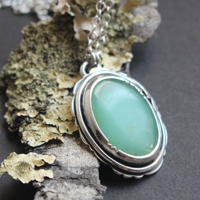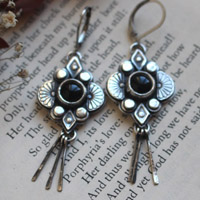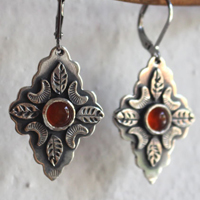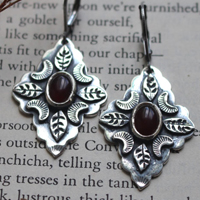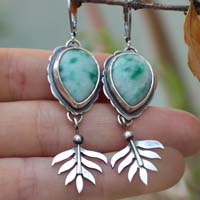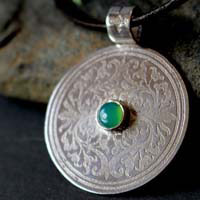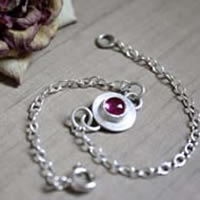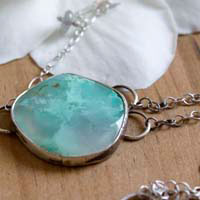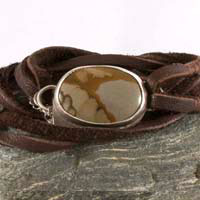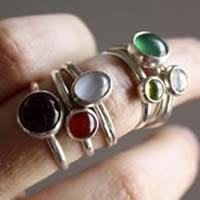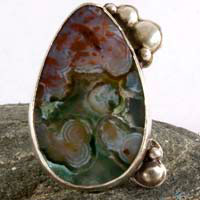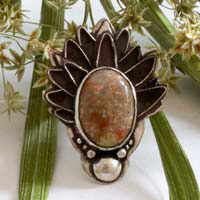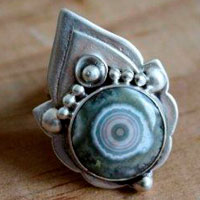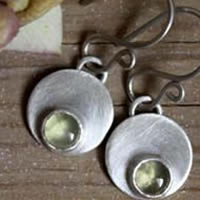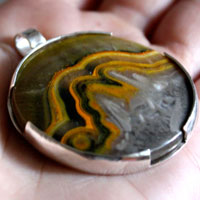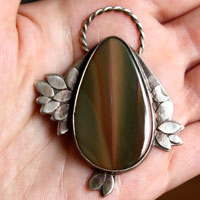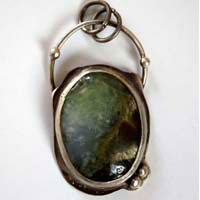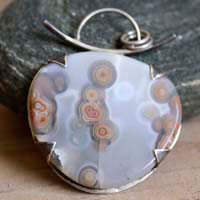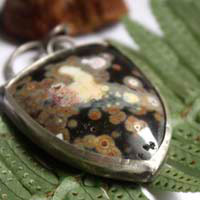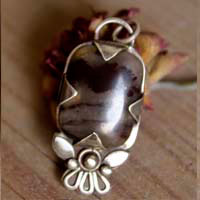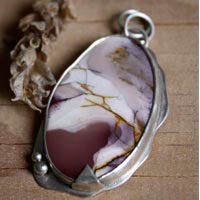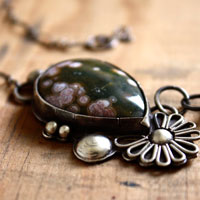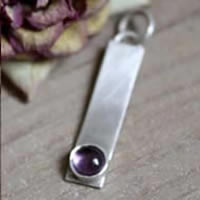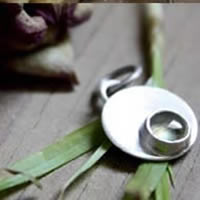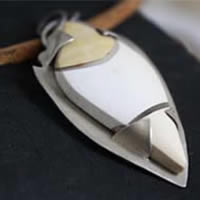- Jewelry
- Inspiration
- Good Deals
- Paintings
- About
- Contact
JEWELRY
- Anklet
- Bracelets
- Brooches
- Cufflinks
- Earrings
- Pendants & Necklaces
- Rings
- Draw your jewelry
- GOOD DEALS
- How to clean your jewel
- Metal we used
INSPIRATION
Jasper: history, healing properties and lithotherapy

Jasper properties

Jasper, a stone of sedimentary or occasionally volcanic origin, is distinguished by its primarily siliceous composition mixed with iron oxides, clays, or other minerals that give it its varied colors and unique patterns.
This stone belongs to the chalcedony family, but its interwoven microcrystalline structure sets it apart with its characteristic opacity. The visible striations, bands, or inclusions in jasper result from the compaction of diverse materials over millions of years.
The varieties of jasper offer a fascinating array of forms and colors:
- Orbicular jaspers, recognizable by their circular patterns.
- Bloodstones and prases, sought after for their deep red or green hues.
- Flint jaspers and plasmas, with enigmatic textures often tied to specific geological formations.
Jasper is also renowned for its durability. With a hardness of 6.5 to 7 on the Mohs scale, it resists scratches and daily wear, although its crystalline nature makes it susceptible to fractures under significant impact. Its dense and compact structure renders it a lasting stone, as evidenced by its use in prehistoric tools and ancient ornaments.
From an etymological perspective, the word jasper originates from the Greek Iaspis and the Hebrew Yashepheh. The latter appears in biblical texts, where it is listed among the stones adorning the breastplate of Aaron, the high priest of the temple. Traditionally identified as a rare and precious green jasper, debates persist regarding its exact nature. The historian Pliny the Elder, in his writings, describes this stone as green and sometimes transparent—an unusual trait for modern jasper, which is typically opaque. This discrepancy hints at possible historical misidentifications of gemstones.
The varieties of jasper
Jasper, a stone of unparalleled geological richness, comes in a multitude of varieties with fascinating patterns and colors. These stones are often named after their region of origin, visual characteristics, or the materials that compose them. Unfortunately, some varieties could not be conclusively confirmed on this list due to differing opinions in the available literature, such as: basanite, petrified wood, cacholong, chrysoprase, carnelian, onyx, sard, sardonyx, and unakite. Below is a selection of varieties with their distinctive features:
- Autumn jasper: With warm hues of red, orange, yellow, and brown, it evokes landscapes and forest leaves in autumn.
- Basanite or lydite: A very hard, black, and opaque siliceous rock historically used to test precious metals.
- Bloodstone (or heliotrope): Dark green with red hematite inclusions, it was considered sacred in ancient times.
- Brecciated jasper: A mix of rock fragments cemented by red silica, often interwoven with hematite inclusions.
- Bruneau jasper: From Idaho, USA, it features banded or layered patterns in beige, cream, and brown tones.
- Bumblebee jasper: Bright yellow and black, this stone contains sulfur, giving it a "bumblebee" appearance. Caution is advised as it may contain toxic minerals.
- Dalmatian jasper: Also known as spotted jasper, it is light beige with black spots caused by tourmaline inclusions.
- Cacholong: A white, opaque common opal.
- Carnelian: A translucent red or orange chalcedony containing hematite.
- Chrysoprase: A rock with shades ranging from leek green to bluish-green.
- Deschutes jasper: From Oregon, it showcases vibrant multicolored patterns ranging from red to yellow, often marked with black or brown veins.
- Imperial jasper: A glossy variety with complex, multicolored patterns.
- Kambaba jasper: Green with circular black patterns, often linked to fossilized marine microorganisms.
- Landscape jasper: With flowing patterns and earthy tones, it evokes natural scenes such as mountains, rivers, or desert landscapes.
- Leopard jasper: Also called leopard skin jasper, it is distinguished by spotted patterns resembling the animal’s coat, in shades of beige, brown, and red.
- Lydian stone: Often black with gray or silver patterns, it is a dense variety historically used to test metal purity.
- Mookaite jasper: From Australia, it stands out with warm tones of red, yellow, and brown, reminiscent of desert landscapes.
- Ocean jasper: Features multicolored circular patterns reminiscent of waves and corals.
- Onyx: Can be either an agate or jasper, depending on its composition.
- Orbicular jasper: Known for its circular patterns, often in concentric layers of varied colors.
- Phtanite: A dark, compact siliceous rock known for its hardness, used in construction or as prehistoric tools.
- Plasma jasper: A dark green jasper sometimes spotted with red, often confused with bloodstone.
- Rainforest jasper: With deep green and brown hues, it mimics organic and natural patterns from lush tropical landscapes.
- Sard: An orange to brown chalcedony variety, similar to carnelian.
- Sardonyx: A stone composed of alternating bands of sard and onyx.
- Silica-Fossilized wood: Fossilized wood filled with jasper, chalcedony, and opal.
- Unakite: A metamorphic rock composed of pink feldspar, green epidote, and quartz.
- Willow Creek jasper: From Oregon, it features soft colors ranging from beige to pink, often adorned with subtle, organic patterns.
- Zebra jasper: Recognized for its black and white alternating patterns, resembling zebra stripes.
- Zoned jasper: Characterized by successive bands of color, often red, yellow, or brown.
History, legends and beliefs on jasper

Jasper, with its many facets, has been a prized material throughout the ages. Used ornamentally, it has adorned fireplaces, tables, pavements, sculptures, and mosaics, lending an elegant touch to every object it graced. Its versatility as a gemstone made it highly sought after in the world of jewelry. Additionally, its durability and natural beauty made jasper a favored choice for creating seals, stamps, and engravings, underscoring its enduring place in art and culture over the centuries.
However, over time, many materials have been mistakenly labeled as jasper, highlighting the importance of accurate identification. This confusion is partly due to the vast variety of stones resembling jasper but belonging to different mineral families. As such, care must be taken to distinguish each type of jasper, and more attention will be given to the unique characteristics of each variety featured on this site.
The Egyptians extensively exploited jasper’s qualities, carving red scarab amulets symbolizing eternal life, as well as serpent-headed talismans made of red jasper or carnelian believed to protect against snake bites. These objects were regarded as spiritual and physical protectors. Egyptian jasper sculptures, such as the famous bust of Queen Tiye carved from yellow jasper, exemplify the significance and mastery of this material in the art and culture of ancient Egypt.
The Greeks associated jasper with Gaia, the mother goddess, endowing it with a profound symbolism of fertility and connection to the Earth. They believed that jasper promoted natural balance and fertility. Additionally, they offered the stone to Callisto, the lunar goddess, in reverence of her nocturnal majesty and connection to the wild. Thus, jasper symbolized earthly and divine power, harmony with nature, and protection.
The Romans dedicated jasper to Bona Dea, the goddess of fertility and chastity, attributing protective qualities to the stone for health and family. This tradition continued in ancient Rome, where jasper was also used to craft amulets and talismans meant to safeguard women and children. Jasper held an essential role in daily life, much like other precious stones.
In Norse legends, jasper appears in epic tales such as that of Siegfried, where the pommel of his sword, inlaid with red jasper, symbolized the dragon’s blood he had vanquished, reflecting his legendary bravery. Jasper, as a stone of strength and victory, was associated with heroic and divine qualities in Norse mythology.
Biblical references grant jasper a sacred aura. In the Old Testament, it is listed as one of the twelve stones adorning Aaron’s breastplate, though its precise identification remains debated. Some modern interpretations suggest this stone was bloodstone, a variety of jasper symbolizing faith and spiritual purification.
In Christian tradition, jasper is also linked to the Apostle Peter, representing the solid foundation upon which the Christian Church is built. This symbolism extends to the Book of Revelation, where the throne of Christ rests upon a base of jasper, symbolizing eternity, renewal, and divine revelation.

Jasper also held significant importance in Native American cultures, where certain varieties were revered as protective amulets. These stones were believed to ward off nocturnal dangers and attract blessings of water and rain, essential elements for life and the fertility of the land. In Native American traditions, each type of jasper was associated with nature spirits, offering wisdom and protection to those who carried them.
In Japan, as early as the Iron Age, jasper was highly valued and used to craft **magatama**, pendants with evocative shapes resembling claws, commas, or the number nine, imbued with a sacred aura. These ornaments were considered relics containing the souls of great warriors and were worn by priests and nobles as distinctive symbols of their high social status. Magatama were also regarded as talismans, believed to ensure prosperity and longevity.
In China, jasper held great cultural significance as well. Imperial seals were carved from this precious stone, symbolizing the emperor’s authority and legitimacy. Jasper was also used in the art of sculpture, depicting mythological and divine forms. It was a mark of high status and a symbol of prosperity, highly coveted by the Chinese nobility.
Mines: you can find it frequently but each mine is unique. India, México, USA, Brazil, Madagascar and Russia.
Healing properties and benefits of jasper
Jasper is a stone with numerous therapeutic and protective properties, cherished for centuries for its beneficial effects on both body and mind.
- It is renowned for supporting the healthy functioning of organs such as the liver, kidneys, bladder, lungs, and stomach.
- Jasper is often used in lithotherapy to help detoxify the body and promote better digestion.
- This stone acts as an emotional stabilizer, reducing anxiety and nervous tension.
- It is also believed to aid in the recovery of the sense of smell after disturbances, harmonizing energies and fostering recuperation.
- Through its balancing effects, jasper enhances the absorption of essential minerals like iron, sulfur, zinc, and manganese, contributing to the optimal functioning of the body. It can also support metabolism and strengthen natural defenses.
- Jasper is used to soothe inflammation and alleviate a variety of ailments, including bronchitis, headaches, joint pain, colds, flu, and even chronic conditions such as multiple sclerosis. It may be combined with relaxation practices to amplify its benefits.
- By promoting better circulation, jasper helps reduce bleeding, including nosebleeds, and alleviate symptoms of hemorrhoids. It is also known to stimulate the circulatory system, thereby boosting vital energy and cellular regeneration.
- In lithotherapy, jasper is often regarded as a stone of vitality and endurance. It helps ground energies, supports the immune system, and encourages self-confidence, making the wearer more resilient to physical and emotional challenges.
Beyond its physical benefits, jasper is widely used to balance the chakras, particularly the root chakra, with which it is closely associated. It fosters deep grounding, providing stability, security, and a connection to the Earth. Different varieties of jasper also possess specific properties based on their colors and patterns:
- Red jasper enhances vitality and physical energy.
- Green jasper brings calm and emotional harmony.
- Yellow jasper stimulates creativity and self-confidence.
- Multicolored jasper combines several virtues, offering holistic protection.
 Please note that all healing properties presented for gemstones are gathered from various sources. This information is provided as a service and is not intended to treat medical conditions. It is recommended to consult a healthcare professional for serious medical issues and not to rely solely on gemstones as a treatment.
Please note that all healing properties presented for gemstones are gathered from various sources. This information is provided as a service and is not intended to treat medical conditions. It is recommended to consult a healthcare professional for serious medical issues and not to rely solely on gemstones as a treatment.
Jasper jewelry samples
To learn more about litotherapy, we recommend you the following books:

